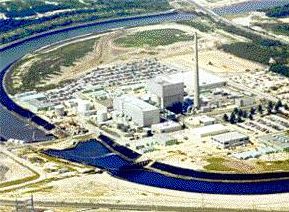Chicago, Illinois based Exelon Corporation recently announced that it will close the Oyster Creek nuclear power plant in 2019. (NY Times, NJ.com AP). Oyster Creek, in Lacey, New Jersey, is the nation’s oldest operating nuclear power plant. It’s roughly 75 miles south of New York City and 60 miles east of Philadelphia. Exelon was recently granted a 20-year extension on its operating license by the Nuclear Regulatory Commission despite the wishes of local environmentalists, environmental groups, and people concerned about evacuations in the event of an emergency, and public concerns from the NJ Department of Environmental Protection.
The plant uses a single pass cooling system which sucks in 500 Billion gallons of cool water each year (click here) from Barnegat Bay, heats it 20 to 30 degrees, and returns the heated water to the bay. This kills billions of adult and juvenile fish, clams, crabs, and shrimp, and hundreds of billions, if not trillions of hatchlings, less than a centimeter in length. This has had a negative effect – possibly a disastrous effect – on the fish and wildlife populations of Barnegat Bay during the 40 year operating life of the plant to date. The NJ DEP demanded that Exelon retrofit the plant with cooling towers.
Exelon claims the cooling towers would cost $600 million, roughly $1.00 per watt for the 610 megawatt reactor. Other estimates for the cooling towers range from $200 million to $800 million. Exelon decided to close the plant rather than spend the money on the cooling towers and other maintenance. This is a gain for current Exelon shareholders as they defer a hundreds of millions on capital improvments, and corresponding hundreds of millions of liabilities, while they collect revenues and realize profits from the sale of electricity for the next nine years.
While cooling towers would not pump heated water into the bay, they would pump steam into the atmosphere – which would have other environmental effects. Looked at from a systems perspectives, nuclear power is a technology for generating electricity, heat, radioactive wastes, which also presents national security challenges.
Dan Yurman, writing in The Energy Collective, suggests that there might be more to Oyster Creek than the economics of avoiding the expense of the cooling towers. “In a December 9 message to subscribers,” he writes, “Morningstar called Oyster Creek the ‘lowest margin plant’ for Exelon, and said that it had been plagued by ‘relatively high operating costs.'”
Like Vermont Yankee (click here) and Indian Point (here), Oyster Creek is associated with leaks of tritium (here). Dennis Zannoni, the former nuclear safety engineer for the New Jersey Department of Environmental Protection, has long held that Exelon was not managing Oyster Creek safely (click here) and its operating license should have been revoked, not renewed. We wrote here about Kerry Beal, the whistleblower who exposed guards sleeping on the job at the Peach Bottom Nuclear Power Plant, and who was fired in 2007 by Exelon Nuclear.
The federal Environmental Protection Agency is expected to draft regulations in 2011 under Section 316 of the Clean Water Act to require power plants to reduce their thermal discharges into the nation’s waterways. This could have significant implications for other power plants, such as Indian Point, on the Hudson River, and the Salem plant on the Delaware.
New Jersey has 311 megawatts of solar energy, about 221 which were installed between June 30, 2009 and Sept. 30, 2010. The energy from Oyster Creek and the other nuclear power plants can easily be supplied by new photovoltaic solar systems and wind turbines. These clean, renewable and sustainable energy technologies operate with significantly lower environmental externalities – no radioactive or other hazardous wastes, no national security concerns, no fuel, therefore no mines, wells, fuel processing and transportation.

